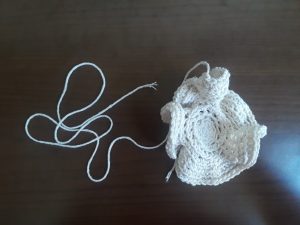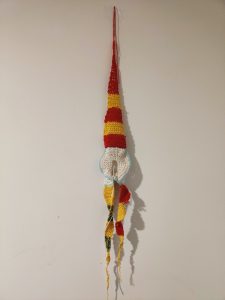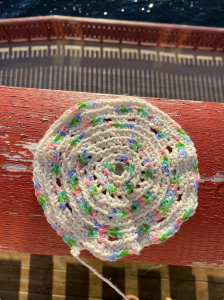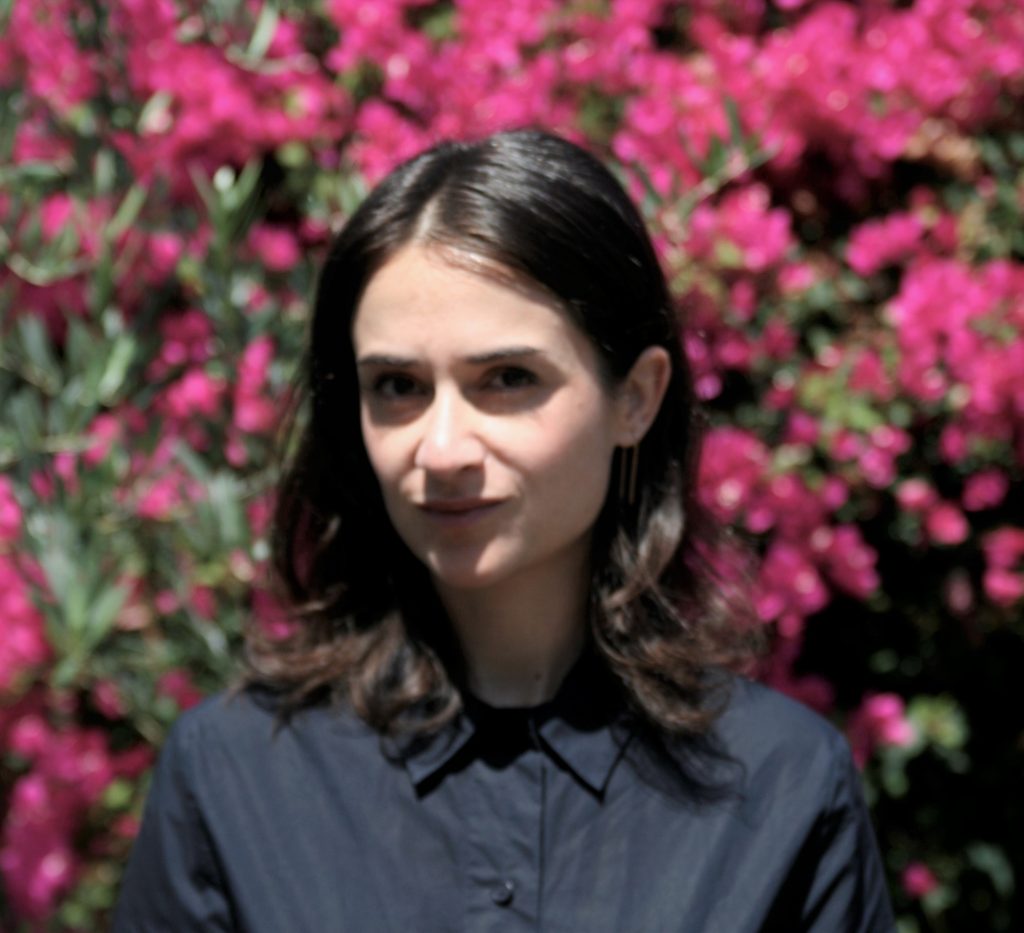I
A rectangle in my screen frames my student’s head, their shoulders and hands. In the background is a dark room with a couple of posters. Gesticulating effusively, my student mimics the movements of needles and yarn. Both hands pinch an invisible cotton thread. Thumb and index fingers touch, as if holding a pencil, insinuating the presence of a crochet hook, which they squeeze, as their other hand circles up and down in the air, tracing the flow of yarn. The rest of us, our heads inside tiny little rectangles too, follow their moves and nod. We recognize in their performance the clumsiness of the novice learner, a humbling feeling of light powerlessness that we have all shared during the semester, as we grapple with the learning of new histories, theories and, less common in the art history classroom, production skills. My student’s demonstration is part of a weekly report on the status of the class’s collectively crocheted purposeless objects crafted during the fall of 2020 during my course “Arts & Crafts as Avant-Garde Labor,” at Swarthmore College. A course that happened, like many others throughout the world, under the spell of the covid-19 pandemic.
This seminar explored the history of an unlike and unstable liaison: the tormentous relationship between practices that the discipline of art history has traditionally classified as either ‘art’ or ‘craft’. This central taxonomy, still recognizable in the art institutional complex, is captured in Immanuel Kant’s foundational treaty on aesthetics, The Critique of the Power of Judgment (1790). There Kant differentiates two kinds of beauty: one that is free and self-sustaining; another that is adherent and purposeful. He calls the first “liberal art” and the second “remunerative art.” This distinction is still engrained in contemporary notions of aesthetic value, and backbones our appreciation of objects that we designate in common parlance as either art or craft following very similar criteria. Beneath it were the seeds of two aesthetic programs that would unfold throughout Euro-American modernity in parallel: one emphasizes the reception of beauty another highlights its production. For centuries, the cultural field has been split between those who understand these paradigms as essentially incompatible given their disparate end goals, and others who envision in their shared appreciation of the sensory a fertile common ground.
The parallel history of these contrasting arguments, which continue to shape our modern understanding of art within academia, art institutions, and the artist’s studio, informed my pedagogy for this course. In order to better understand the motives that led artists, theorists, and industrialists through Euro-American modernity to support or deny the compatibilities of these two fields of practice, students and I read and discussed primary and secondary sources, yes; but in our efforts to grasp the nuances of their analysis, we sought to partially embody these conversations by embracing, too, the positionality of producers engaged in the collaborative making of beautiful objects — purposeful some, purposeless others.
Collaboration has the capacity of sparking in humans the joyful awareness of our shared experience. If done outside of coercive conditions, it reminds us of the value of crafting and cultivating bonds, the advantages of sharing skills, and the benefits of learning from others. Collaboration is also, like many have argued before me, a way of organizing production that renders awesome fruits such as monumental landmarks, detailed embroideries, and the finest musical productions. Yet its potential has been overlooked by a paradigm of artistic value that foregrounds individualism and genius as requisites for beauty –whereas beauty is visually contemplated and intellectually appreciated, instead of produced and cultivated with our bodies and our senses in togetherness. Centering collaboration in the art history classroom allowed us to inhabit, for a semester, the other side of this historical divide. We role-played, if we may, to experience the field otherwise.

Besides its benefits for material production, the cultivation of togetherness nourishes intellectual work. This notion is well articulated by poet and theorist Fred Moten, for whom thinking ought to happen in proximity with others. Pondering the relationalities that scaffold the humanities classroom, he writes to his students that thinking “is inseparable from reading and writing. Thinking, reading, and writing—in process and in common— is the work you are supposed to have been doing for this class.”1Fred Moten, “Anassignment Letters,” Stolen Life (Durham: Duke University Press, 2018). It is the “in common” aspect of this thinking that interests me, at a time of increased competitiveness within and outside academia, and heightened anxiety among students about bleak professional futures. I agree with Moten’s critique that traditional humanities assignments are oftentimes individualist propositions for students to agree, for a moment in time, on a particular perspective on a topic, thus temporarily adopting this or that subjectivity in the cultivation of discipline. Moten writes: “The rules [of the traditional assignment] are designed to impose upon you the necessity of simulating, in your intellectual activity, the achievement of the very subjectivity that our classes have been calling into question. What you’re supposed to be doing, by yourself, so you can be (de)graded, accounted for, and properly separated from one another, is showing that you have become a self-possessed and self-contained intellectual subject.” For Moten, by defending these positions, students follow the syllabus as a script, enacting the drama of intellectual history. With Moten, I wonder about the potential of approaching this temporary embodiment of the discipline from production processes: What if in addition to embodying the perspectives of this or that art historian, most of them writing from the receiving end of beauty, we embodied together a different positionality regarding beauty, that of collaborative producers of beautiful things?
II
Yet as the new pandemic state of affairs loomed over us during the summer of 2020, I reconsidered what it would mean to teach a class that foregrounded the importance of collaborative creative production to a group of students displaced around the planet. My plans needed to change as we no longer would be sharing a room, nor could we practice my ideal of a workshop where the slow learning of artisanal skills scaffolded discussions about histories and theories. What logistical and material changes would my plans need? How would crafting objects together be possible, if none of us were in the same room? Would the sadness and hopelessness of the moment dampen the joys of crafting in togetherness –whatever form that might take? And, more importantly, what about the other benefits of collaboration, those that transcend the end goal of the material object itself and extend into life?
I decided to send crochet kits to my students, who were, at this point, dispersed throughout the world. In addition, I sent three purposeless starters, that is, three little circles crocheted with cotton yarn, to three of my students, who would work on these objects for a week and then send them to someone else, who would in turn send them to others and so on. I hoped that this assignment would trigger thoughts about togetherness and learning, and move them to embody the discipline from another position, at least for some days. As they crafted during the semester, I asked them to reflect on the experience.
And the students wrote:
That there is not such a thing as uselessness or purposelessness, but suspended and rehearsed detachment, only possibly maintained under the right conditions. Adero Kauffmann-Okoko toyed with achieving and preserving this ideal: “I was initially thinking about what I could do in order to make this object have the least possibility of being used for something. I ran through different possible manipulations in my head and wondered how or if they could be appropriated for a use. For example, if I closed the circular hole, could the object not just be used as a cover for something or even as a coaster for a drink? If I connected a chain of stitches to any part of the object, could that not be used as a handle of some sort? I even considered just adding ornamentation, like a border of some sort, but ornamentation does not create an inherently purposeless object, it just detracts from the object, purposeful or not, as Adolf Loos says.”
That producing beautiful things, purposeless or purposeful, can in fact lead to the cultivation of care and belonging. And that the distinction might not matter as much as the grounding effect that understanding beauty as production might have on us as we make. Like Kristina Stalvik remembers, “when I received the object in the mail I began to contemplate whether ‘purposeless’ was actually a suitable title in the first place. If a central purpose of craft is to express care, build communal ties, imbue daily life with ritualistic importance, and recycle found material, then this small crocheted object is teeming with it! During the object’s stay in my possession, I took it with me to my grandparents house on the Trondheim fjord. This is the farmland that my family has resided on for generations; visiting always gives me a surprising sense of calm and stability. Bringing the object into this space felt like a poignant part of adding to the inter-spatial network of material and emotion created by mailing it around to everyone in our class. It filled me with a sense of awe that due to the strange scattering of this term, an object crocheted by Paloma in Pennsylvania could absorb the brackish fjord air.”
That production processes, like materials, have inherent properties that unfold through our sensory engagement with them. Matt Koucky explored these values in their crocheting: “Laurel Fredrickson recounts of Vladimir Tatlin, that ‘[he] held that design could derive from exploring and exploiting a material’s intrinsic properties.’ I think something similar can be said of culturally-encoded processes, such as crochet. I was exploring not only the properties of the substance I was using, but also the properties of the crocheting process. There are limits. You can’t just do what you want or keep going without constant reflection on whether the object you are making will function as expected.”
That centering production, for some, was humbling and reminiscent of the clumsy beginnings of learning. That far from revering a canon that upheld detached optical, after-the-fact, beauty, it would now be time, even for a minute, to displace themselves and embrace other histories of artistic value, such as those enacted by subjects excluded from the Euro-American canon. Lee Cohen remembers that he “began by rejoining the smiling clown’s arm to its body using some superglue I had on hand. It was from this point that I began thinking about where there seemed to be room to add. I was interested in somehow engaging with both Paloma’s starter directly and the other, blue, circular crochet piece that Eva had made and contextualized as the complementary collar. I hoped to somehow directly join these two pieces, as I found them already contending with one another for the small amount of space between the clown’s heads. While I noticed how the clowns were holding hands, their collars were competing with one another. But how could I join them? With my crocheting skill still not being very robust, it seemed improbable that I could join them effectively. But, my breakthrough came when recalling Harmony Hammond’s braided rug rags. While those pieces are surely complex and the symbol of the braid is one that is particularly loaded, the senses of ‘cobbling together,’ strengthening, joining, and making-due evoked by the braid seemed to be particularly fitting for what I hoped to accomplish here: to make due with my less than ideal crocheting skills while hoping to join and unify the two existing pieces of crochet more directly by linking them.”

That against the sweeping sadness of the early pandemic months, before vaccines twinkled in the horizon, crocheting, if graceless at first, brought joy and playfulness for some. Eva Baron recalls when, still new to the technique, she was at what Anni Albers called the “playful beginning” of fiber arts. She wrote: ”by virtue of the assignment itself as well as the experimentation that had not yet been superseded by ‘practicality,’ I embraced the ‘uselessness’ of the object I received and quickly crocheted an accompanying doily with blue yarn. With the yarn slipping through my fingers, the petals blossoming out toward me as I weaved in and out through my stitches, I dipped into the rhythmic ‘enjoyment of colors, forms, surface contrasts, and harmonies,’ a ‘sensuousness’ that otherwise would’ve been recontextualized into an almost sterile utilitarianism. As with all my other previous crochet projects, this doily was fundamentally imperfect—I had accidentally skipped stitches and, with the resulting asymmetry and shrinkage, my doily buckled and transformed into what appeared to be a concave flower.”
That being engaged in the production of beautiful things, purposeful or not, is being engaged emotionally, too, with ourselves. Like Eva Low recalls, “Frustrated by my first two ‘failures,’ I set out to make the largest and best tentacle yet. I had perfected the art of skipping stitches, and was ready to add the red yarn back into the mix. Minutes into the creation of the base of my third tentacle, my plastic crocheting hook snapped as I tried to pull a loop through an opening. I became slightly distraught and saddened, thinking that this was the world telling me it was simply not meant to be. I was also surprised and intrigued by the fact that I was so emotionally invested in this piece as its creator, even knowing that this object was as ugly as it was, and without purpose. Dewey came to mind, as he argues that artistic engagement relies on the emotional engagement of the laborer themself, as they must be interested in their handiwork and not only the final product. After giving up and sulking for a few hours, I equipped myself with my larger metal crochet hook and, with a renewed sense of vigor, delved into the tricky formation of the final tentacle. At last- success! The third tentacle was as perfect as and as purposefully hideous as I imagined it to be.”
And that navigating the fine line between purposefulness and its absence is certainly worth it if you are inspired by magic circles, like Emma Miller was. “I had plans for what purposeful objects I wanted to make (cat hats) that required an understanding of how to make magic rings so I decided to use this purposeless object to experiment as I would have the range to explore different ways of making circles. I made little boots for the Kirbies, as well as little dangly ‘coins’ I called them to hang from the ribbons. These coins I wanted to evoke rage and frustration, as they kept getting tangled up. I partially wanted to make these hang off as it reminded me of a jester’s hat, inspired by Eva Baron’s clowns on her other piece that she had shown the class earlier.”
III
And although we were all apart, it felt a little bit less so. I wouldn’t call what we had togetherness, but we did engage in the collaborative production of beautiful things together, thanks to the postal service. As students of art history, we tried as a group to challenge the distinction between the purposeful and the purposeless, removing our study from the reception of beauty to center, instead, its production. It’s hard to tell up to what point we accomplished this ambitious goal, but we all felt a little bit less alone, learned practical and theoretical skills, histories of these things called art and craft, and produced a set of world-touring objects that testify to our experiencing things otherwise.

This essay is part of our series on teaching and scholarship in the rupture.
Notes
- 1Fred Moten, “Anassignment Letters,” Stolen Life (Durham: Duke University Press, 2018).

